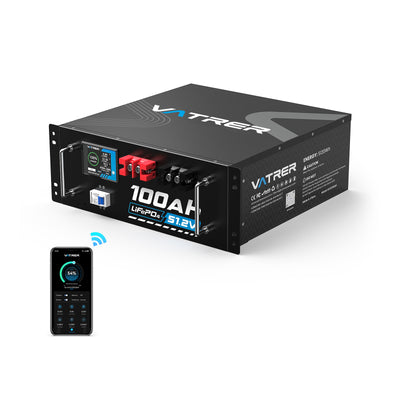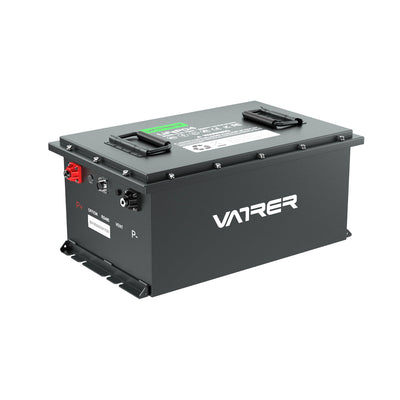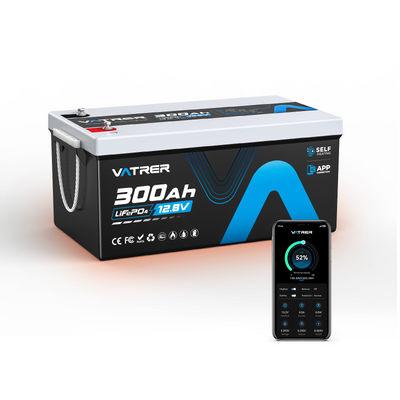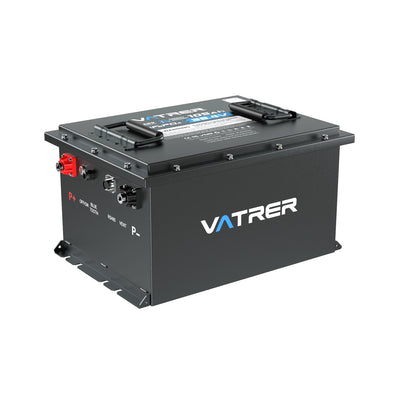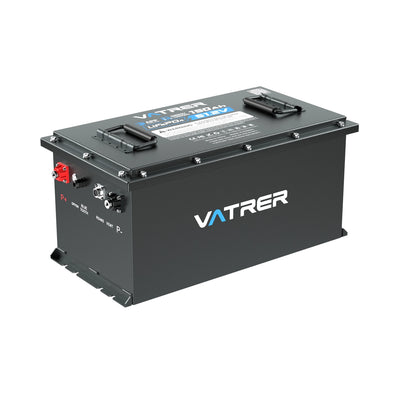
What Is The Best Deep Cycle Battery?
Getting ready for a camping weekend, heading out on the lake, or building an off-grid solar setup? In all of these situations, a dependable deep-cycle battery is at the heart of your power system, supplying steady energy for essentials like your RV fridge, lighting, or trolling motor.
Unlike a standard car battery, which is meant to deliver a short burst of power to start an engine, deep-cycle batteries are built for sustained output over long periods. That makes them crucial when choosing the best deep-cycle RV battery or the best deep-cycle marine battery.
Because there are so many options on the market, this guide walks through why deep-cycle batteries matter, compares the main types, and shares practical guidance to help you pick the right model for camping, marine use, or a solar storage battery so you can count on reliable power wherever you go.

What Is the Best Deep Cycle Battery and How Does It Work?
Unlike starter batteries, which are designed to deliver a brief, high-current surge to turn over an engine, deep-cycle batteries are engineered to supply a steady flow of power over many hours.
They can be discharged much more deeply—often down to 80% of their capacity or more—without harm, which makes them well suited for running gear like fridges, lights, or trolling motors while camping, boating, or living off-grid.
What really sets the best deep cycle battery apart is its internal construction. Lead-acid deep-cycle models rely on thicker lead plates, while LiFePO4 batteries use advanced lithium chemistry. Both approaches are meant to withstand frequent charge and discharge cycles.
The best 12V 100Ah deep cycle battery can deliver about 1,200Wh of energy, which is enough to keep a 100W fridge running for around 12 hours. That kind of durability provides a dependable power source for demanding setups like camping rigs or small solar systems.
Deep-cycle batteries store and release energy through chemical reactions. In lead-acid designs, lead plates react with a sulphuric acid electrolyte to create electrical energy, while lithium batteries rely on lithium ions moving back and forth between the electrodes.
The ability to tolerate deep discharges and recharge efficiently—especially in LiFePO4 batteries with a rated lifespan of 2,000–5,000 cycles—is what makes these batteries stand out in long-term use.
Vatrer 12V LiFePO4 batteries can power onboard electronics such as fish finders or navigation equipment, making them a smart choice in compact spaces where every centimetre counts. This versatility makes them particularly practical for deep-cycle applications in marine and RV environments.
Interested in digging deeper into how deep-cycle batteries work? Have a look at the following:
What is a 12V deep-cycle battery?
Can I use a deep-cycle battery with LiveScope?
Comparing Common Types of Deep Cycle Batteries
To identify the best deep cycle battery for your setup, it helps to understand the main technologies available. Each type has particular strengths, which makes it better suited to certain uses, such as marine, RV, or solar power systems.
Flooded Lead-Acid (FLA) Batteries
Flooded lead-acid batteries are typically the lowest-cost deep-cycle option. They use lead plates submerged in a liquid electrolyte made of sulphuric acid and water. However, they do need regular upkeep, including topping up with distilled water every one to three months and providing adequate ventilation so hydrogen gas can safely dissipate. Thanks to a mature recycling system (around 99% recyclable in the U.S.), they remain a budget-friendly and environmentally responsible choice. That said, their weight and the requirement to stay upright make them less convenient for mobile applications such as trolling motors or frequent trailer use.
AGM (Absorbed Glass Mat) Batteries
AGM batteries are sealed, maintenance-free lead-acid batteries where the electrolyte is held in fibreglass mats. They tolerate vibration well, can be mounted in different orientations, and are a strong fit as deep-cycle batteries for camping or RVs. They typically support 500–800 cycles at 50% depth of discharge (DoD) and offer an expected life of about 5–8 years. With a mid-range price point, they’re a flexible option for RVs, boats, and similar mobile set-ups.
Gel Batteries
Gel batteries are another type of sealed lead-acid battery, but they use a gelled electrolyte. This provides excellent spill resistance and good durability in more extreme temperature ranges. They are designed to handle deeper cycling—up to about 800 cycles at 50% DoD—making them suitable for marine electronics, RV systems, or industrial gear. Their downsides are a higher purchase price and slightly lower discharge capability compared with AGM, which limits their use in high-current applications.
Lithium-Ion (LiFePO4) Batteries
Lithium Iron Phosphate (LiFePO4) batteries are widely viewed as one of the best choices for a 12V deep-cycle battery because they are lighter, last longer, and operate more efficiently. They are virtually maintenance-free, can charge up to about five times faster than typical lead-acid batteries, and can be discharged to 100% of their capacity without causing damage. At around 80% DoD, they can usually deliver 2,000–5,000 cycles, which is far beyond the lifespan of most other deep-cycle battery types. A built-in battery management system (BMS) helps prevent overcharging, over-discharging, and thermal runaway, significantly improving safety. This makes them an excellent option when choosing a solar battery for home storage or a deep-cycle battery for RVs.
Why Lithium (LiFePO4) Excels for Deep Cycle Needs
Compared with traditional deep-cycle lead-acid batteries, lithium models generally deliver stronger performance across the board (deep cycling up to 80%, rapid charging, and virtually no maintenance). That’s why they have become the preferred option in many deep-cycle applications. Key advantages include:
- Longer Lifespan: Around 2,000–5,000 cycles at 80% DoD, compared with roughly 200–500 cycles for many lead-acid batteries, which means fewer replacements over time.
- Higher Efficiency: They can provide their full rated capacity across different discharge rates, while lead-acid batteries may lose 20–30% of usable capacity under heavier loads.
- Faster Charging: They can accept higher charge currents (up to about 0.5C), which is ideal for solar systems paired with the best deep cycle battery charger, such as MPPT controllers that can improve charging efficiency by 20–30% versus PWM units.
- Lightweight Design: Generally 50–70% lighter than comparable lead-acid batteries, making transport and installation easier for camping, boating, or RV use.
- Safety: A BMS—often certified to standards such as UL 1973 and UN 38.3—helps prevent overcharging, overheating, and short circuits.
- Temperature Resilience: They can retain around 90% of their capacity at 0°C, while lead-acid batteries at the same temperature may drop to roughly 50–60%.
Take the Vatrer 12V 100Ah trolling motor battery as one example. It can run a 55lbs thrust motor at half speed for about 4–5 hours, whereas an AGM deep-cycle battery of similar capacity might only manage 2–3 hours.
Powering Your Adventures with the Best Deep Cycle Battery
Deep-cycle batteries are highly versatile and can support a wide variety of applications where continuous power is important. The suggestions below can help you match battery types to typical use cases:
- Camping: Choose the best deep-cycle camping batteries to run your fridge, lighting, or fans when you’re off-grid.
- Boating: Use the best deep-cycle marine batteries to power trolling motors, fish finders, and navigation systems.
- RVing: Install the best deep-cycle RV batteries to run appliances like microwaves, televisions, or air conditioners.
- Solar Systems: Choose the best deep-cycle solar batteries to store power from your solar array for off-grid or backup use at home or the cottage.
- Industrial: Use deep-cycle batteries designed for electric vehicles to power forklifts, golf carts, or critical backup systems.
Beyond picking a battery chemistry, you’ll also want to factor in how much energy you actually use. For instance, an RV user might require about 1,200 watt-hours per day: a 100W fridge (around 800Wh over 8 hours), a 20W light (about 100Wh over 5 hours), and a 30W phone charger (roughly 300Wh to fully charge multiple devices).
Buying a group 24 best deep cycle battery with 100Ah capacity (approximately 1,200Wh of energy) can cover that load and provide reliable power over the course of a week-long trip.
You can also use Vatrer's online calculator to size a battery system tailored to your actual energy consumption.
Curious about how deep-cycle batteries fit into different setups? The resources below go into more detail to support your final decision:
What Is a Deep Cycle Lithium Battery Used For?
What Is The Best Deep Cycle Battery For a RV
Key Factors to Find Your Best Deep Cycle Battery
Choosing the best deep-cycle battery comes down to balancing your power requirements, operating conditions, and overall budget. Here is a simple step-by-step approach:
- Energy Consumption: Estimate your total daily energy use and add a 20–30% buffer so the battery is not pushed to its limits every day, which helps extend its lifespan.
- Application and Environment: Select the battery based on where and how it will be used. For example, for the best deep-cycle battery for a trolling motor, a lithium-ion or AGM battery is a solid choice because both handle vibration well. For the best deep-cycle battery for solar power, lithium-ion is often preferred due to its fast charging capability and compatibility with MPPT controllers.
- Budget: As a general guide, a 100Ah flooded lead-acid battery might cost around $100–$200, AGM options $200–$400, gel batteries $250–$450, and lithium between $500 and $1,000. While lithium is more expensive upfront, the longer service life and fewer replacements can make it more cost-effective over time.
- Charging Compatibility: Lithium batteries work best with MPPT charge controllers or dedicated lithium chargers that optimize the charge profile. Lead-acid batteries can be used with PWM or more basic chargers, but they require regular care to avoid sulphation and early failure.
The comparison table below gives a quick overview of how the main battery types stack up in terms of cost, lifespan, and typical use:
| Battery Type | Upfront Cost (12V 100Ah) | Lifespan (Cycles at 80% DoD) | Maintenance | Best For |
|---|---|---|---|---|
| Flooded Lead-Acid | $100-$200 | 200-500 | High (water, ventilation) | Budget, stationary use |
| AGM | $200-$400 | 500-800 | None | RVs, marine, camping |
| Gel | $250-$450 | 500-800 | None | Marine, RVs, industrial |
| Lithium (LiFePO4) | $500-$1,000 | 2,000-5,000 | None | Solar, marine, RVs, long-term use |
Conclusion
The best deep-cycle battery for you will depend on your specific setup, but LiFePO4 batteries often come out ahead thanks to their long lifespan, strong efficiency, and high safety margin. That combination makes them a top option for the best deep cycle battery for solar, the best deep cycle marine battery, or the best deep cycle battery for camping.
If you’re working with a tighter budget, flooded lead-acid or AGM batteries can still be a reasonable choice, provided you are prepared to carry out regular maintenance.
By calculating your energy needs, taking your environment into account, and selecting a trusted brand such as Vatrer Battery, you can power your trips and projects with confidence.
FAQs/People Also Ask
Who Makes the Best Deep Cycle Battery?
Several established manufacturers produce reliable deep-cycle batteries. Options such as Vatrer Battery are particularly well suited to deep-cycle use in marine, RV, and solar applications. For instance, the Vatrer 12V 100Ah and 200Ah batteries are rated for roughly 2,000–5,000 cycles at 80% depth of discharge. They also include a built-in BMS and Bluetooth monitoring so you can track charging and status in real time.
What Is the Best Deep Cycle Battery for Solar?
LiFePO4 batteries work very well with solar because they can accept high charging currents and pair efficiently with MPPT solar charge controllers. Compared with PWM units, MPPT controllers can increase usable solar input by about 20–30%. Unlike many lead-acid batteries, which lose capacity when discharged at higher rates, lithium iron phosphate batteries provide consistent output, which is important when solar production varies with weather and daylight. For these reasons, deep-cycle lithium batteries are often the preferred option for storing solar energy in off-grid homes, cabins, or backup systems.
Share


































